In urban conditions, the issue of harvesting storage is relevant, since due to the lack of space in the apartment, you have to come up with various methods. It is logical to create a cellar on the balcony or arrange a mini-storage for vegetables. The container set aside for these purposes can be made a recreation area.
Requirements for creating a cellar on the balcony
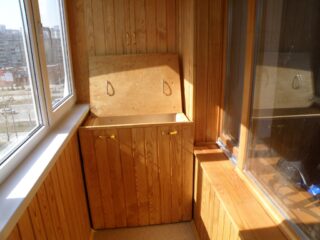
When arranging a cellar on a balcony, it is necessary to follow the principles of arrangement. The shelf life of the crop depends on the creation of a microclimate in the boxes. This is influenced by the following factors:
- Temperature from +1 to + 5 ° С, humidity at the level of 85-90%.
- Ventilation system with a damper in severe frost.
- Lighting - it is necessary to create darkness in the containers.
- Reduced gas exchange - bagged storage. It is not recommended to use synthetics as materials.
- Compliance with the rules of the food neighborhood.
Industrial vegetable stores are equipped with devices that automatically control the level of humidity and temperature. For the balcony version, you can use relay sensors.
Cellar options on the loggia
In search of the best option for arranging a vegetable store on a loggia, you can study the finished product. The models are classified into the following categories:
- Containers - moisture and heat levels are regulated by water-repellent textile layers. We serve as a filler cellular synthetic winterizer.
- A thermos is a box in which the conditions are as close as possible to a real cellar. The design can be portable or stationary.
- With heating system - products are equipped with automatic microclimate control. It is difficult to create such a device on your own, since it is necessary to equip forced ventilation. It is recommended to get acquainted with the manufacturers of Topoleko, SKT ovens and others.
Separately, it is worth considering the option of arranging a basement on the first floor. Such events require obtaining permission from the Criminal Code in the event that the loggia goes to the highway or the main street. In addition, the refurbishment should not constructively change the facade of the house.
Choosing a mini vegetable storage
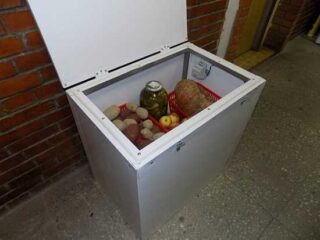
Ready-made cellars for the balcony are produced in two types - hard and soft structures. The models are supplied to the market in different sizes and are designed for year-round storage of vegetables. Due to differences in specifications, please check the operating conditions before purchasing the product.
Hard
Rigid products are made of plastic or metal with chrome plating. Models are available in volumes of 100, 200 and more liters. Products are made for both a small balcony and a large loggia.
Basic equipment of hard cellars:
- thermometer;
- forced ventilation system;
- powered by electricity;
- devices for maintaining the microclimate when the device is de-energized.
Ventilation prevents condensation from accumulating inside the drawer, which reduces the risk of rotting vegetables due to excessive humidity and stagnant air. In hard cellars for loggias, crops can be stored all year round.
Electricity consumption in structures belongs to class A +. When the light is temporarily switched off, the ovens are able to maintain the same temperature for 24 hours.
Flexible
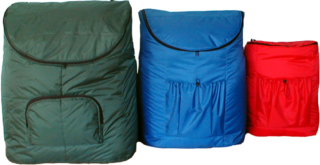
Flexible cellars look like a thermo-refrigerator or a sports bag. The main plus of the product is mobility: the model can be taken with you to the dacha, put away for storage. The construction is made of waterproof textiles with padding polyester insulation. Electrodes are sewn into the walls, which, when connected, create optimal conditions for storing the crop.
Features of flexible cellars:
- mains supply;
- use on the balcony at -40 ° C;
- the presence of a screen on some models with the output of information about the microclimate;
- automatic switching on and off of heating when the temperature changes.
However, most of these models can be used only in the off-season, since the material of the walls of the container is not suitable for winter storage of vegetables.
Cellar manufacturing technology
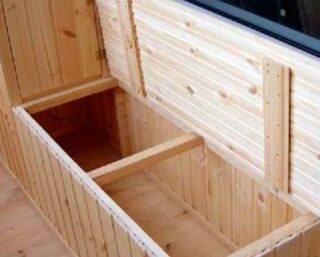
The purchase of a ready-made cellar for the apartment allows you to equip the balcony with a compact and aesthetic device. However, a homemade box is cheaper. You can make a structure from scrap materials by purchasing insulation and fasteners in the store. Before construction, it is necessary to create drawings and draw up an estimate based on them.
An old refrigerator or a similar container can be used as a cellar.
Step-by-step instructions for making a cellar with your own hands
Take a beam, boards, hinges and screws. A screwdriver and a saw must be prepared as tools. The instructions provided are for the built-in type of boxes. Therefore, first, at the installation site, attach the bars to the floor in the shape of a rectangle, set the upper ones along the height of the structure.
Do-it-yourself step-by-step algorithm for creating a cellar on the balcony:
- If the property is not located in regions with severe frosts, a simple ventilation system is sufficient. To do this, use boards - stuff them not tightly, but leaving a small gap.
- Attach the panels to the façade and walls. The upper part will be the lid, so install the furniture hinges on it. The thickness of the top depends on further use - if you plan to rest on top of the box, choose reliable materials.
- To create a hatch, saw off 2 bars as wide as an opening. Stuff the boards across. Attach a handle or leather strap on top to open the balcony cellar.
- Cover the inside of the container with insulation. For these purposes, you can use polystyrene or penoplex.
- Additionally, put together another smaller box for free installation inside the main container. Here you need to use thin boards, for example, plywood, thick cardboard or fiberboard. Insulate the cover in a similar way.
- Apply a deep-penetrating primer to the surface and paint the cellar with stain.
You can buy a thermal container or make it yourself. The second option is more exciting, because it saves the budget and allows you to create an original thing in the style of an apartment. Inside, you can make drawers for storing small things, and lay out pillows on top, equipping a resting place.
Features of storing food on the balcony
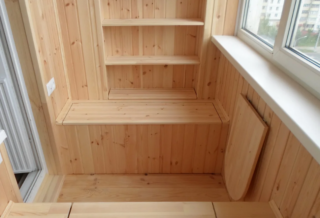
The use of a cellar for storing vegetables on the balcony is important for apartments in multi-storey buildings. The area in such real estate is often limited, so every meter must be used rationally.
Low temperature indicators in winter make it possible to equip a loggia as a place for storing crops from a summer cottage. Gardeners advise creating conditions close to 0 ° C. To maintain the correct mode, the balcony must be glazed and insulated. If the apartment is located in a region with cold winters, it is necessary to organize heating in the form of convectors or external radiators.
The main factor in storing vegetables is product compatibility. The optimum is the allocation for each culture of the container. However, with limited space, this condition is problematic. In view of this, vegetables should be stored in accordance with the rules of the neighborhood, using cotton bags.








